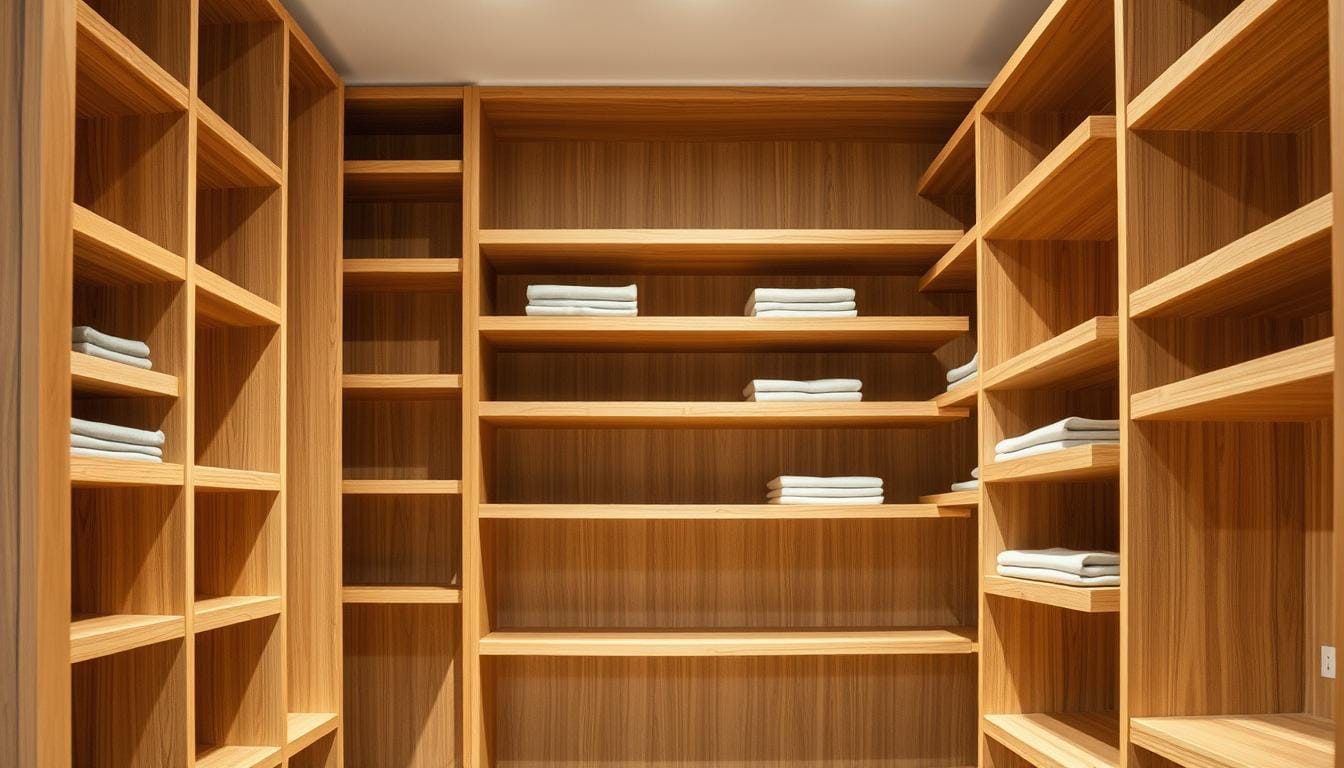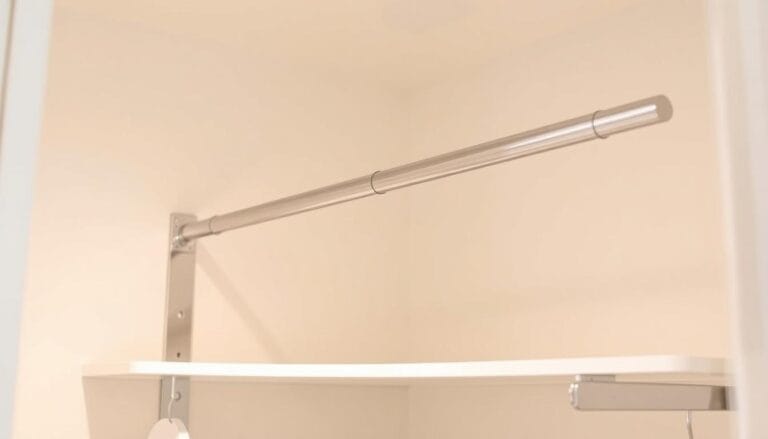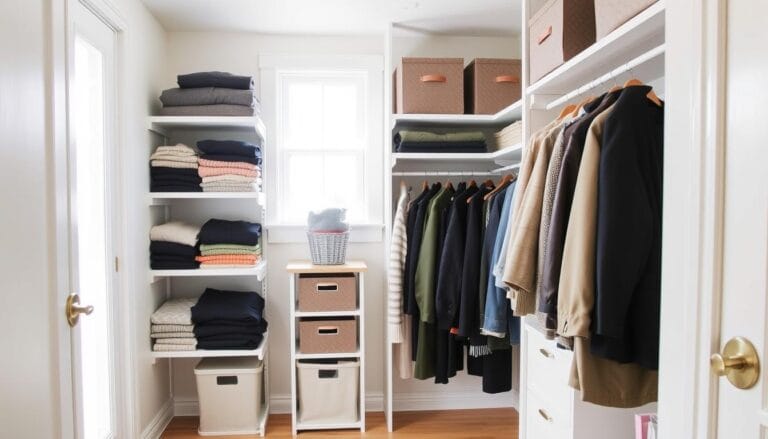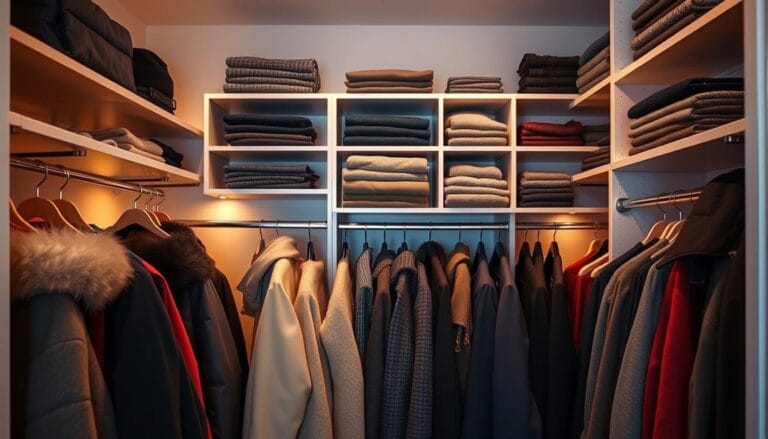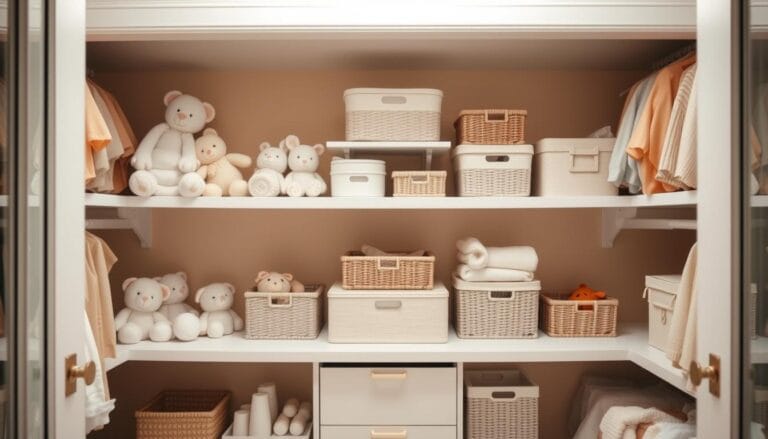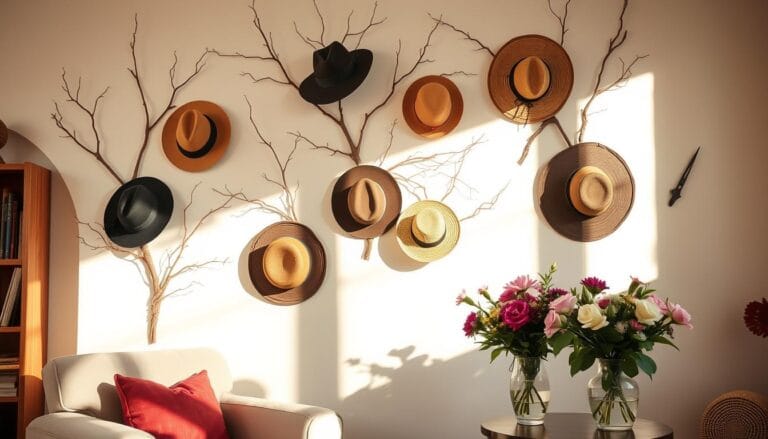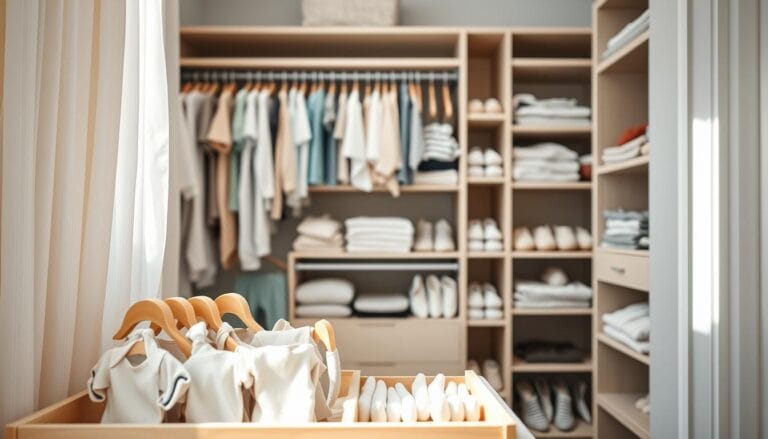How to Choose the Best Wood Closet Shelves for Your Space
Table of Contents
Standing in my cluttered closet, I knew something had to change. Years of disorganized storage had turned my peaceful space into a chaotic mess. This mess stressed me out every morning.
That’s when I found the power of high-quality closet storage solutions. They can change your space from chaotic to calm.
Choosing the right wood closet shelves is more than adding storage. It’s about making your closet a functional, beautiful part of your home. Your closet can become a peaceful, organized sanctuary.
Wood closet shelves are versatile, durable, and look great. They can make any closet, big or small, more organized and efficient.
In this guide, you’ll learn how to pick wood closet shelves that fit your needs and style. We’ll cover materials, design, and how to install them. This will help you create the perfect storage for your home.
Understanding Different Types of Wood Closet Shelves
Choosing the right wood for your shelves can change your closet and home’s look. Each wood type has its own look, strength, and how well it works. This affects the look and feel of your shelves.
Solid Wood vs. Engineered Wood Options
Solid wood shelves are classic and last a long time. They have natural patterns that warm up your closet. Engineered wood is cheaper and doesn’t warp as much.
Popular Wood Species for Closet Shelving
Each wood species has its own benefits for shelves. Pine is light and cheap. Oak is strong and has cool grain patterns. Cedar is good for clothes because it resists moisture and smells nice.
Veneer and Laminate Alternatives
Veneer and laminate are cheaper but look like expensive wood. They’re great for those who want style without spending a lot. They’re perfect for stylish storage without breaking the bank.
What wood you choose depends on what you need, how much you want to spend, and what you like. Think about how much moisture it will get, how much it will hold, and what it will look like.
Measuring Your Closet Space for Perfect Shelf Fit
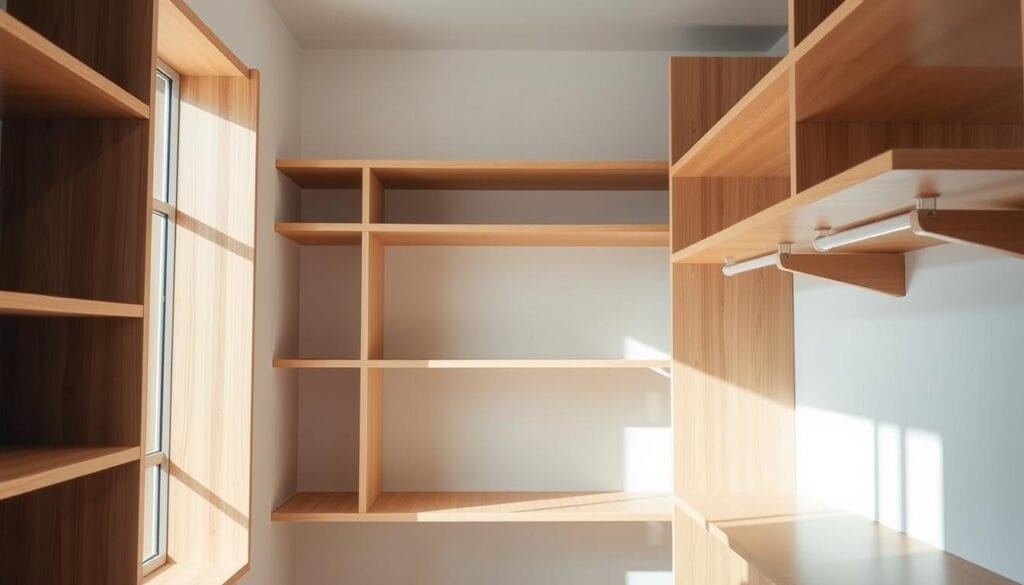
Starting a closet organization project means getting the measurements right. Before buying wood shelves, measure your closet carefully. Use a metal tape measure and a notebook to record the details.
First, measure the closet’s width from one wall to the other. Take several measurements at different heights because walls can be uneven. Also, note the depth of your closet, which decides how deep your shelves can be. Closets usually range from 22 to 24 inches deep, but you can customize for unique spaces.
Next, measure the vertical space between shelves. Shelves are usually 12 to 16 inches apart, depending on what you store. Think about what you’ll put on the shelves – clothes, shoes, or storage boxes. This will help you decide on the right shelf height and layout.
Remember to check for obstacles like outlets, switches, or fixtures. These can affect your shelving design. Make a simple diagram with your measurements to plan the layout and ensure a perfect fit.
Pro tip: Add half an inch to your measurements for wall variations and easier installation. Getting your measurements right is key to a successful closet shelving project.
Key Features to Consider in Custom Wood Shelving
When you’re picking out custom wood shelving for your closet, think about a few key things. You want a system that’s both useful and looks good. It should last a long time and work well.
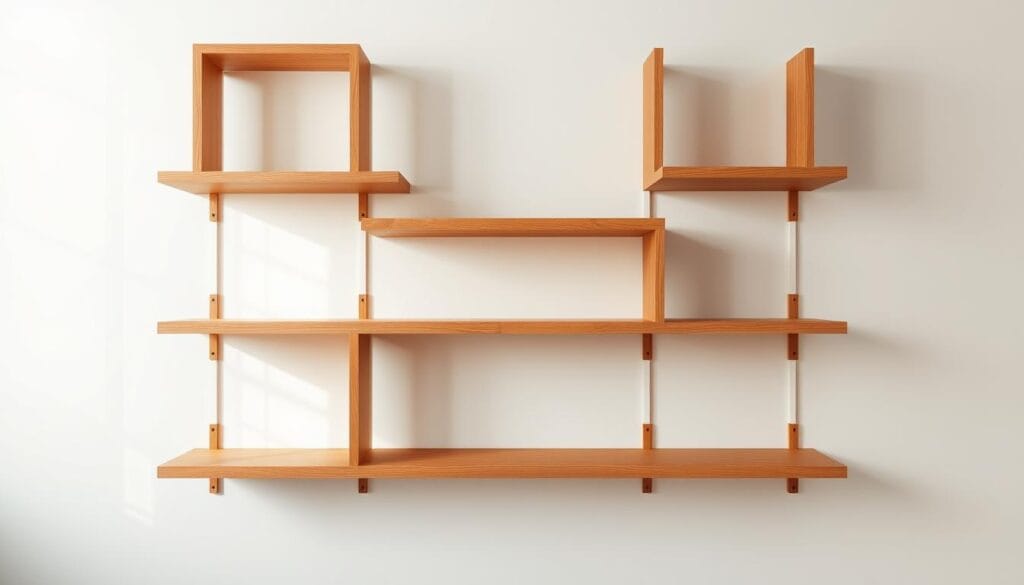
Weight Capacity and Structural Support
It’s important to know how much weight your shelves can hold. Different woods and designs can handle more or less. Hardwoods like oak and maple are strong and can hold heavy items.
Finish Options and Durability
The finish of your shelves affects how they look and last. Sealed wood keeps out moisture and prevents damage. Choose finishes like polyurethane or lacquer for protection and to keep the wood looking natural.
Installation Methods and Hardware
How you install your shelves is key to their stability. Use strong brackets and wall anchors for a secure fit. Pick hardware that fits your shelves and matches your space’s style.
Benefits of Adjustable Wooden Shelves
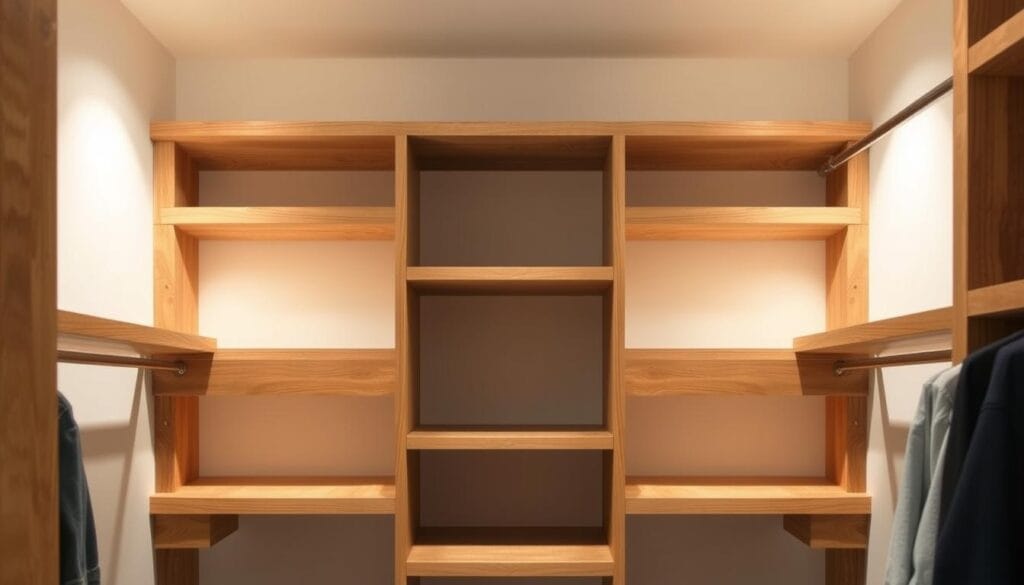
Changing your closet storage doesn’t have to be hard. Adjustable wooden shelves are a smart choice for making your closet more organized. They let you adjust the shelves to fit your needs, whether your wardrobe changes or your lifestyle does.
Adjustable wooden shelves are very versatile. They can hold everything from big winter sweaters to small accessories. You can move them to use more space, thanks to different ways to adjust them.
These shelves let you make your closet your own. You can store tall boots, folded shirts, or even bins for accessories. The wood adds warmth and beauty, and it lasts a long time.
These shelves do more than just adjust. They help you use every bit of space in your closet. This means less clutter and a more organized home. By choosing these shelves, you’re getting a storage system that fits your life perfectly.
Modern Design Trends in Wood Closet Shelves
Wood closet shelving has changed a lot in recent years. It’s now more than just a place to store things. It’s a stylish statement in your home. People want closet storage that looks good and works well.
Contemporary Styles and Finishes
Today’s closet shelves are sleek and simple. They have clean lines and neutral colors. Finishes like light oak and walnut are popular because they add warmth without losing style.
Matte and textured finishes add depth and elegance. They make your storage look sophisticated.
Integration with Existing Decor
It’s important to choose shelves that match your room’s style. Look for wood tones or neutral colors that fit with your furniture. Floating shelves and built-in systems make your space look neat and organized.
Space-Saving Solutions
Modern closet shelves are now more than just shelves. They have features like adjustable compartments and pull-out racks. These help you use your space better and keep it tidy.
You can customize these shelves to fit your needs. This way, you get a storage solution that’s perfect for you.
DIY Installation Tips for Wood Closet Organization
Turning your closet into a space with wood shelves is a fun DIY project. It can make your storage area much better. First, get the right tools like a level, drill, and measuring tape. It’s important to plan well for a successful closet makeover.
Begin by measuring your closet carefully. Mark where you’ll put the shelves on the wall. Make sure to find wall studs for strong support. A stud finder helps find these points, keeping your shelves stable.
Choose wood shelves that fit your space and can hold the right amount of weight. Cedar and pine are good choices because they’re durable and look nice. Before drilling, make holes to avoid splitting the wood. Use the right wall anchors for extra support.
Always wear safety goggles and work carefully with power tools. If you’re not sure about something, ask a pro or watch videos. Your effort will pay off with a closet that’s both stylish and functional.
Getting the shelves to line up and be level is key. Take your time and double-check your measurements. Enjoy making a storage space that shows off your style and meets your needs.
Maintenance and Care for Wood Closet Storage Systems
Keeping your wood closet racks in good shape is key. High-quality closet storage can last for years with the right care. Your wooden shelves are a valuable investment that needs protection from daily wear and damage.
Essential Cleaning Techniques
Regularly dust and clean your wood closet shelves with a soft microfiber cloth. Stay away from harsh chemical cleaners that can harm the wood’s finish. For a deeper clean, use a wood-specific cleaner mixed with water. Always test a small, hidden area first to avoid damage.
Preventive Care Strategies
Keep your closet storage dry and away from direct sunlight. Use felt pads under heavy items to prevent scratches. Rotate stored items to avoid uneven weight. Check shelf supports and brackets yearly to keep everything stable and prevent damage.
Long-Term Preservation Tips
Keep your closet’s humidity levels consistent. Wood can change size with big temperature changes. Use a dehumidifier or silica gel packets to control moisture. Check your shelves every season for wear, loose parts, or damage that could harm your storage.
Cost Comparison of Different Wood Shelving Options
When planning your closet, knowing the cost of custom wood shelving is key. Prices vary based on materials, design, and how customized it is. Basic shelves cost $100 to $500, while top-notch custom ones can be $500 to $2,000.
Pine wood is the cheapest option, starting at $5 to $10 per foot. Hardwoods like oak or maple are pricier, costing $15 to $30 per foot. Your choice depends on what you need, how it looks, and your budget.
DIY fans can save by buying materials and making their own shelves. A simple DIY project might cost $200-$400 in materials. This is less than the $800-$1,500 for a pro to install it. Think about your skills and time before deciding.
Professional services offer complete solutions, including design, materials, and installation. They’re pricier but give you a tailored storage solution. A full custom closet system can cost $800 to $2,500.
Smart shoppers compare prices, check material quality, and think about long-term value. High-quality custom wood shelving can improve your home’s organization and even boost its value.
Environmental Considerations and Sustainable Wood Choices
Choosing wood closet shelves affects the environment. Opting for sustainable wood makes your storage space eco-friendly. Look for products certified by the Forest Stewardship Council (FSC). This ensures forests are managed responsibly and natural habitats are protected.
Modern closet shelving now includes green options. Bamboo is a fast-growing, low-resource wood choice. Reclaimed wood from old buildings adds character and reduces deforestation.
It’s also key to consider how wood products are made. Choose brands with eco-friendly finishes and waste reduction. This supports forest conservation and lowers your carbon footprint, without losing quality or style.
Your choices can help the environment. Research brands that care about sustainability. Understand where the wood comes from and pick materials that match your values. Even small decisions in home organization can make a big difference.

